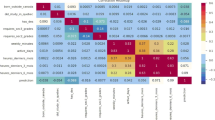Abstract
Nowadays, web-based courses are popular as students can learn at their convenience and according to their free time. One advantage is the availability of study materials that can be used in a blended learning program. However, it suffers from a high withdrawal problem. This article contributes to the research by proposing a withdrawal prediction framework based on the Open University, a large distance-learning institution. The study contribution is a dropout prediction framework. The prediction process includes handling missing data using the MissForest algorithm, tackling imbalanced data issues using SOMTEFUNA, reducing dimensions using PCA, and training different classifiers. The experiments show Decision Tree classifier as the best predictive model with an F1-score of 0.99. The proposed framework outperforms other researches by 12% when compared to the previous research work.
Access this chapter
Tax calculation will be finalised at checkout
Purchases are for personal use only
Similar content being viewed by others
References
S. Jiang, D. Kotzias, Assessing the use of social media in massive open online courses. arXiv:1608.05668 (2016)
W. Li, M. Gao, H. Li, Q. Xiong, J. Wen, Z. Wu, Dropout prediction in MOOCs using behavior features and multi-view semi-supervised learning. in 2016 international joint conference on neural networks (IJCNN) (IEEE, 2016), pp. 3130–3137
M. Tan, P. Shao, Prediction of student dropout in e-Learning program through the use of machine learning method. Int. J. Emerg. Technol. Learn. 10(1) (2015)
M.C. Mihaescu, P.S. Popescu, Review on publicly available datasets for educational data mining. Wiley Interdiscip. Rev. Data Mining Knowl. Discov. e1403 (2021)
M. Shridharan, A. Willingham, J. Spencer, T.-Y. Yang, C. Brinton, Predictive learning analytics for video-watching behavior in MOOCs. in 2018 52nd Annual Conference on Information Sciences and Systems (CISS) (IEEE, 2018), pp. 1–6
J. Kuzilek, M. Hlosta, Z. Zdrahal, Open university learning analytics dataset. Sci. data 4(1), 1–8 (2017)
J Kuzilek, J. Vaclavek, V. Fuglik, Z. Zdrahal, Student drop-out modelling using virtual learning environment behaviour data. in European Conference on Technology Enhanced Learning (Springer, Cham, 2018), pp. 166–171
M. Hussain, W. Zhu, W. Zhang, S.M.R. Abidi, Student engagement predictions in an e-learning system and their impact on student course assessment scores. Comput Intell Neurosci (2018)
H. Heuer, A. Breiter, Student success prediction and the trade-off between big data and data minimization. DeLFI 2018-Die 16. E-Learning Fachtagung Informatik, 219–230 (2018)
R. Alshabandar, A. Hussain, R. Keight, A. Laws, T. Baker, The application of Gaussian mixture models for the identification of at-risk learners in massive open online courses. in 2018 IEEE Congress on Evolutionary Computation (CEC) (IEEE, 2018), pp. 1–8
S. Rizvi, B. Rienties, S.A. Khoja, The role of demographics in online learning; a decision tree based approach. Comput. Edu. 137, 32–47 (2019)
L. Haiyang, Z. Wang, P. Benachour, P. Tubman, A time series classification method for behaviour-based dropout prediction. in 2018 IEEE 18th International Conference on Advanced Learning Technologies (ICALT) (IEEE, 2018), pp. 191–195
A. Ramesh, S.H. Kumar, J. Foulds, L. Getoor, Weakly supervised models of aspect-sentiment for online course discussion forums. in Proceedings of the 53rd Annual Meeting of the Association for Computational Linguistics and the 7th International Joint Conference on Natural Language Processing (vol. 1: Long Papers, 2015), pp. 74–83
F. Hlioui, N. Aloui, F. Gargouri, Withdrawal prediction framework in virtual learning environment. Int. J. Serv. Sci. Manag. Eng. Technol. (IJSSMET) 11(3), 47–64 (2020)
D.J. Stekhoven, P. Bühlmann, MissForest—non-parametric missing value imputation for mixed-type data. Bioinformatics 28(1), 112–118 (2012)
A.S. Tarawneh, Smotefuna: synthetic minority over-sampling technique based on furthest neighbour algorithm. IEEE Access 8, 59069–59082 (2020)
G. Dimic, D. Rancic, N. Macek, P. Spalevic, V. Drasute, Improving the prediction accuracy in blended learning environment using synthetic minority oversampling technique. Inf. Discov. Deliv. (2019)
S. Wold, K. Esbensen, P. Geladi, Principal component analysis. Chemom. Intell. Lab. Syst. 2(1–3), 37–52 (1987)
F. Pedregosa, G. Varoquaux, A. Gramfort, V. Michel, B. Thirion, O. Grisel, M. Blondel et al, Scikit-learn: machine learning in Python. J. Mach. Learn. Res. 12, 2825–2830 (2011)
F. Hlioui, N. Aloui, F. Gargouri, A Withdrawal prediction model of at-risk learners based on behavioural indicators. Int. J. Web-Based Learn. Teach. Technol. (IJWLTT) 16(2), 32–53 (2021)
K. Palani, P. Stynes, P. Pathak, Clustering techniques to identify low-engagement student levels. In CSEDU (2), 248–257(2021)
Author information
Authors and Affiliations
Corresponding author
Editor information
Editors and Affiliations
Rights and permissions
Copyright information
© 2022 The Author(s), under exclusive license to Springer Nature Singapore Pte Ltd.
About this paper
Cite this paper
Jawthari, M., Stoffa, V. (2022). OULAD Learners’ Withdrawal Prediction Framework. In: Singh, P.K., Singh, Y., Chhabra, J.K., Illés, Z., Verma, C. (eds) Recent Innovations in Computing. Lecture Notes in Electrical Engineering, vol 855. Springer, Singapore. https://doi.org/10.1007/978-981-16-8892-8_52
Download citation
DOI: https://doi.org/10.1007/978-981-16-8892-8_52
Published:
Publisher Name: Springer, Singapore
Print ISBN: 978-981-16-8891-1
Online ISBN: 978-981-16-8892-8
eBook Packages: Intelligent Technologies and RoboticsIntelligent Technologies and Robotics (R0)




